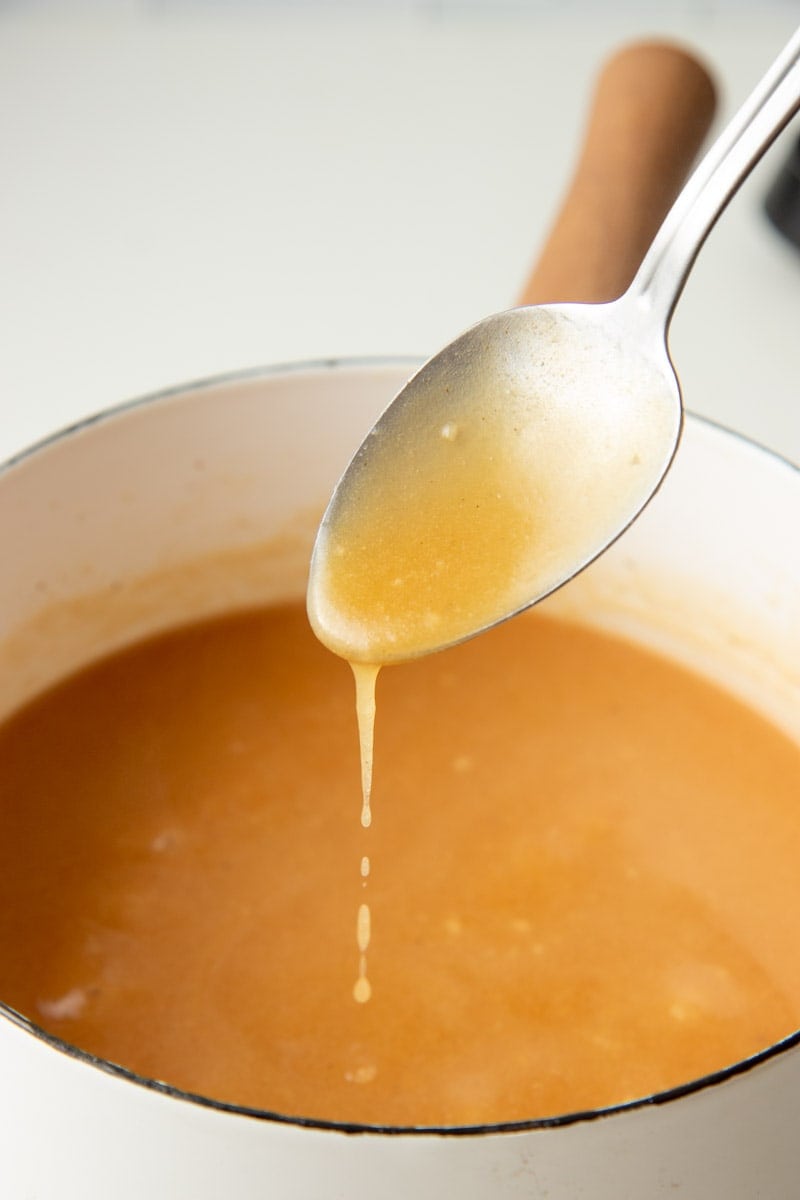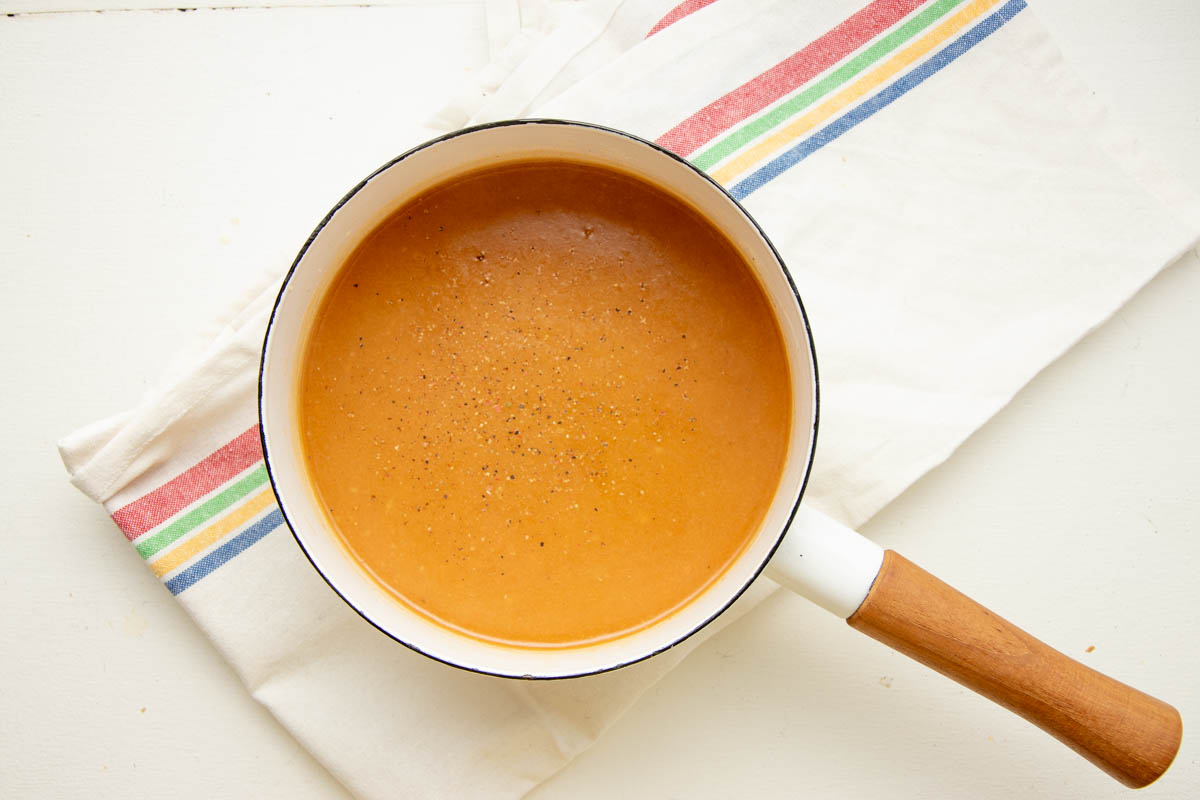Get ready to elevate your Thanksgiving dinner with the most luscious and no-fail turkey gravy recipe ever! Whether it’s drizzled onto mashed potatoes or juicy roast turkey, this gravy is the final dressing that takes your feast to the next level!
Making gravy might sound intimidating, but trust us, it’s a breeze. In this simple guide, we’ll walk you through the steps to create velvety, flavorful gravy that will have your guests begging for seconds. So, roll up your sleeves, grab that turkey drippings pan, and let’s dive into the world of delicious, homemade turkey gravy.

What is the secret to good gravy?
Good gravy really comes down to just two things: intense savory flavor and velvety smooth texture. No lumps here! We’re going to show you how to get both of those things down pat so your holiday meal is perfect.
Ingredients in homemade turkey gravy
Homemade turkey gravy only requires four ingredients! Here’s what you’ll need:
- Turkey pan drippings—this is all the fat and juice that collects at the bottom of your turkey roasting pan while roasting your bird. In a pinch, you can make gravy without drippings (we’ll show you how below).
- All-purpose flour—we’ve also used gluten-free flour with good results.
- Salt
- Pepper
Can you teach me how to make turkey gravy from scratch?
The hardest part of making gravy from scratch (and it isn’t hard at all!) is separating the drippings. We highly recommend a fat separator—they’ll run you about $20, last for years, and will make your Thanksgiving prep so much easier. But if you don’t have a fat separator, no worries. You can still make gravy! Here’s how to do it both with and without a fat separator:

- Separate the drippings: Pour the pan drippings through a strainer into a fat separator or a glass measuring cup. Allow the drippings to rest until the fat is separated from the liquid broth.
- Measure the fat and broth: If using a fat separator, pour the broth into a separate bowl and reserve the fat. If using a glass measuring cup, use a ladle or kitchen spoon to scoop out the fat layer into a separate bowl or glass measuring cup. Measure out the listed amounts in the recipe for both fat and broth.
- Make a roux: Whisk 1/4 cup of fat and 1/4 cup flour in a saucepan over medium heat. Cook while stirring constantly for 2-3 minutes, or until the mixture starts to brown.
- Make the gravy: Slowly pour in the broth, whisking constantly as you pour. Bring the gravy to a simmer and cook until it is just thickened enough to coat the back of a spoon.
- Season to taste: Remove from heat and adjust seasoning.
Protip: Gravy thickens as it cools!
Gravy will thicken slightly as it cools in the gravy boat or other serving dish, so don’t make it too thick right in the saucepan.
I don’t have enough drippings (either fat or broth) to make gravy. What do I do?
- If you are a little short on the broth after separating the pan drippings, you can top off to 2 cups with turkey or chicken broth.
- If you are a little short on the fat after separating the pan drippings, you can top off using melted butter or olive oil.

How do you make turkey gravy without pan drippings?
No turkey drippings? No problem. Just substitute 1/4 cup butter in place of the turkey fat and 2 cups of store-bought or premade turkey or chicken broth in place of the broth to make a shortcut gravy.
What can I add to turkey gravy for more flavor?
The flavor of your turkey gravy will rely heavily on the quality of the drippings you use—so it’s a good thing you make a super flavorful roast turkey recipe!
But if you find your gravy lacking a little, you can add some chicken bouillon to boost the flavor. Start small—half a cube or the equivalent if you are using powdered bouillon or paste. You don’t want the gravy to get too salty!
Protip: Add herbs as needed!
Because we usually make turkey gravy using pan drippings from our Herb-Roasted Turkey Recipe, the drippings are usually flavored with enough herbs and spices to not need extras when making the gravy. If you prefer, you can add small amounts of dried parsley, thyme, sage, or rosemary (starting with 1/4 teaspoon) to add more flavor.

How can I make my turkey gravy thicker or thinner?
- If your gravy is too thin: Remember that gravy will thicken slightly as it cools. But if it’s still too thin, whisk together one tablespoon of cornstarch or arrowroot powder with 1/4 cup chicken broth or water until smooth. Add to the gravy and whisk over medium-low heat until thickened.
- If your gravy is too thick: Just whisk in a couple of tablespoons of water or chicken stock, and repeat until the gravy is thin enough.
How do I fix lumpy gravy?
The best way to fix lumpy gravy is to prevent it in the first place. Make sure you whisk vigorously when you add the broth to the roux while making the gravy. Still lumpy? Just strain your gravy through a fine mesh sieve and discard the lumps. No one will ever know!

Should I use the giblets to make gravy?
The giblets of the turkey (the extra bits and bobbles that come with a whole turkey—heart, gizzards, liver, and turkey neck typically) are another way to make a flavorful and rich gravy.
That recipe is slightly different in that you make a turkey stock using all the giblets first and then use that stock—plus the chopped-up cooked giblets—to make the gravy. Giblet gravy has a more rustic texture and appearance, and while it is a favorite of many folks, we tend to prefer the smooth pan-drippings turkey gravy for our Thanksgiving table.
What do I do with leftover gravy?
Leftover gravy stashes wonderfully in an airtight container in the refrigerator for up to a week. Gravy also freezes great! Cool completely, then transfer it into freezer-safe food storage containers—we like using half-pint or wide-mouth pint canning jars. Label and freeze. Use within six months.
Feeling overwhelmed by prepping for Thanksgiving dinner?
Our Ultimate Thanksgiving Planner can help! This isn’t a cookbook—it’s your field guide to a stress-free Thanksgiving dinner. It has:
- How to time your cooking so that everything is ready and still warm when it is time to eat.
- Suggestions on what to prep ahead so that you have time to sit down and enjoy a cocktail with your guests while the turkey is cooking.
- A food calculator so you know what size turkey to buy, how many sides to make, and how many bottles of wine to stock up on.
- A complete grocery list, organized by section of the grocery store.
- And so much more!
You can find our Thanksgiving Planner here.

Turkey Gravy Recipe
Just in time for Thanksgiving, learn how to make a delicious turkey gravy with this easy to follow recipe—it makes perfect gravy every time!
Ingredients
- 3 cups turkey pan drippings (fat and juice)
- 1/4 cup all-purpose flour (gluten-free all-purpose flour also works)
- Salt and pepper, to taste
Instructions
- Pour the turkey pan drippings through a fine sieve or strainer into a fat separator or a large glass measuring cup. Allow the drippings to rest for about 5 minutes or until the fat is separated in an even layer from the broth.
- If using a fat separator, pour out the broth into a separate bowl or glass measuring cup. Measure out 1/4 cup of the fat and 2 cups of the broth. Discard any extra. Set both aside.
- If using a glass measuring cup, use a ladle or kitchen spoon to scoop out the fat layer into a separate bowl or glass measuring cup—it doesn’t have to be perfect. Measure out 1/4 cup of the fat and 2 cups of the broth. Discard any extra. Set both aside.
- In a saucepan over medium heat, add the 1/4 cup of fat and 1/4 cup flour. Whisk together until it turns into thick lumps. Cook, stirring constantly, for 2-3 minutes, or until the mixture just begins to brown slightly.
- Pour in the 2 cups of broth, whisking constantly as you pour. Whisk vigorously until all lumps disappear. Bring to a simmer and cook until just thickened enough to coat the back of a spoon—about 5 minutes. The gravy will thicken slightly as it cools.
- Remove from heat, taste, and adjust seasoning. Depending on how much salt you use in your turkey roasting recipe, you might not need to add salt.
Notes
- No turkey drippings? No problem. Just use 1/4 cup butter in place of the turkey fat and 2 cups of chicken, turkey, or vegetable stock in place of the broth to make a shortcut gravy.
- If you are a little short on the broth after separating the drippings, you can top off to 2 cups with chicken, turkey, or vegetable stock.
- If you are a little short on the fay after separating the drippings, you can top off using melted butter or olive oil.
- Lumps? If you didn’t quite get the lumps out after adding your broth, no problem. Just strain your gravy through a fine mesh sieve and discard the lumps. No one will know!
- Too thin? Remember that gravy will thicken slightly as it cools. But if it’s still too thin, whisk together 1 tablespoon of cornstarch or arrowroot powder with 1/4 cup chicken broth or water until smooth. Add to the gravy and whisk over medium heat until thickened.
- Too thick? Just whisk in a couple of tablespoons of water or chicken broth, and repeat until the gravy is thin enough.
- Not enough flavor? Test for seasoning first by adding more salt or pepper, but if you need more flavor, crumble in half a chicken bouillon cube and whisk until well combined.
Nutrition Information:
Yield: 8 Serving Size: 1/2 cupAmount Per Serving: Calories: 110Total Fat: 4gSaturated Fat: 1gTrans Fat: 0gUnsaturated Fat: 2gCholesterol: 55mgSodium: 89mgCarbohydrates: 3gFiber: 0gSugar: 0gProtein: 15g
At Wholefully, we believe that good nutrition is about much more than just the numbers on the nutrition facts panel. Please use the above information as only a small part of what helps you decide what foods are nourishing for you.


